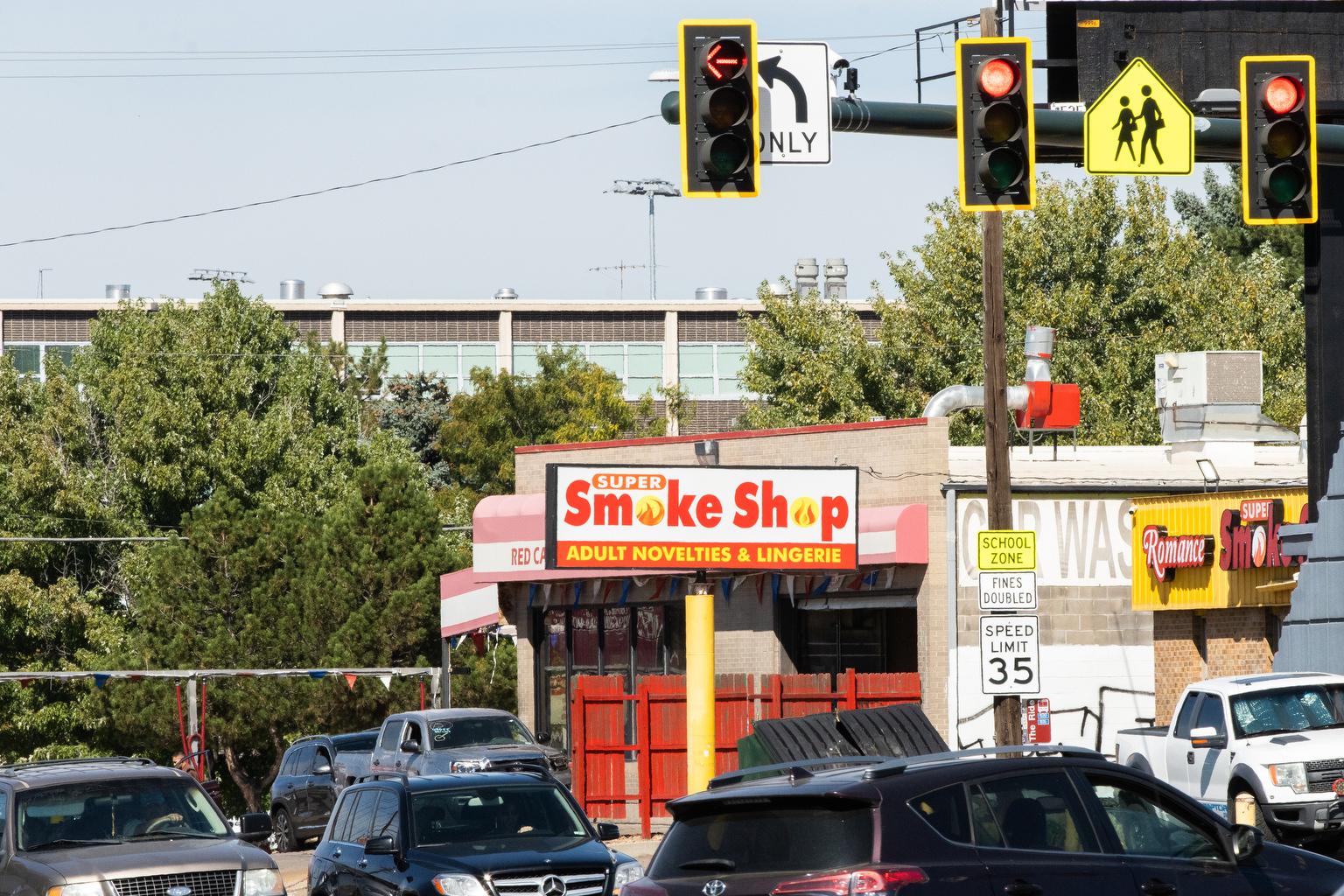
Editor’s Note: CPR News has spent months talking with teenagers, parents, doctors, advocates, researchers, political figures, and others. We’ve looked through once-secret internal industry documents released by tobacco companies and listened to many hours of city council and legislative debate. What we found is that the conversation about tobacco products, especially flavored ones like menthol, is not only about nicotine’s deadly effects or the impact on local economies. It’s about ethics, optics, and equity.
Youth vaping rates nationally and in Colorado have dropped in recent years. But one in six Colorado high schoolers currently use e-cigarettes.
In many neighborhoods, it appears to be relatively easy for a minor to buy vapes or cigarettes in a nearby store, according to data from the city of Denver and the most recent survey of youth statewide.
This is important because retail sales are key to how hard or easy it is for young people to consume highly addictive tobacco and nicotine products. Tobacco use is the No. 1 preventable cause of death and disease in the U.S. and Colorado, as well as the state’s capital city. Each year, nearly 500,000 people nationally die from tobacco-related diseases. That includes more than 5,000 Colorado lives.
Teens that CPR News spoke to said despite the risk, the products are easy to get and are found just about everywhere.
Flor Velasco-Hernandez, a junior at Manual High School in downtown Denver, recently sat on a bench at a park next to the school.
“So right under my feet it is tobacco leaves,” she said.
On the concrete, there were also cigar butts, packaging and filters. She said vaping and smoking are common in bathrooms and outside the school.
She said students have no problem getting these products.
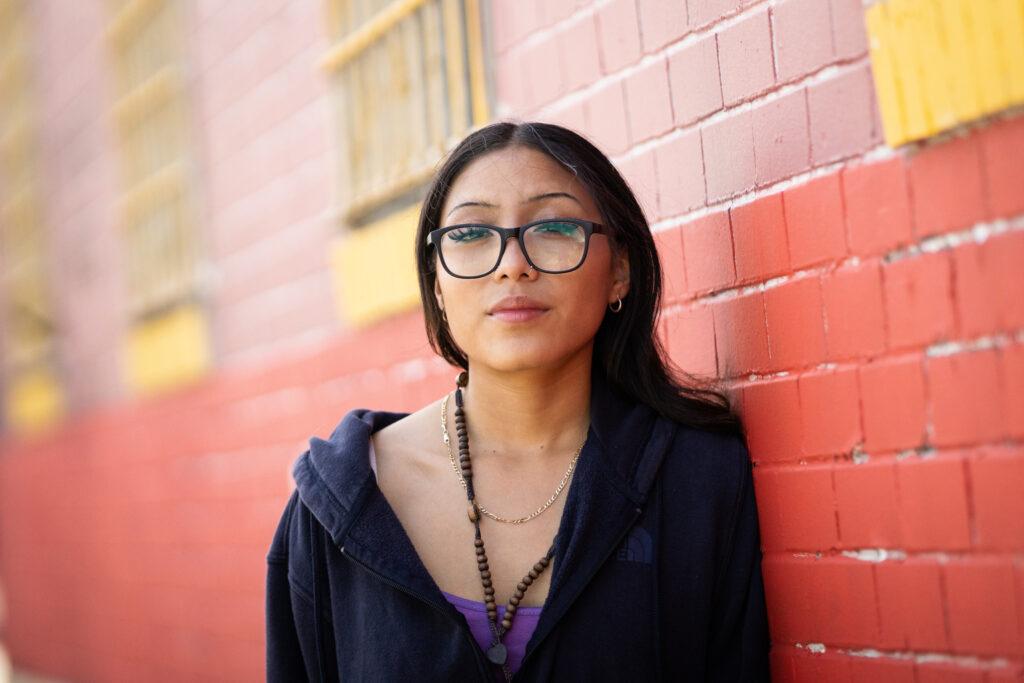
“I mean, I definitely see it everywhere. Oftentimes in lunch, there'll be kids out here that are smoking or stuff like that,” said Velasco-Hernandez.
“It's easy for a young person to get a hold of tobacco and vaping products," said Lucy Roberts, Manual High's school nurse.
She noted tobacco use is frequently passed on from generation to generation, especially in communities historically targeted with marketing by industry.
“It's also historically been a part of their families,” Roberts said, making it “ingrained and a part of what they've grown up with.”
A few years back, vaping had burst onto the scene with young people.
Teens started vaping in skyrocketing numbers, leading to major health concerns. Colorado led the U.S. in youth consumption at one point, with a quarter of high schoolers using an electronic vapor product, double the national average.
In the wake of that, Denver’s Michael Hancock administration set up a tobacco licensing program.
CPR asked the program for information about tobacco retailers — there are about 580 of them — and a list of violations. They also provided us with a spreadsheet tracking those violations. It includes those from after fines went into effect last year.
The information shows the name of the store; the type of store; whether it’s a convenience store, liquor store, tobacco shop, or hookah retailer; and the type of product, for example, cigarettes, e-cigarettes, cigarillos. The document also records this question: “Did employee ask for ID?”
Reading down the list of individual violations, a trend becomes clear; Yes, no, no, no, no, no, yes. No, no yes, no, no, no.
A lot of stores are not checking for ID, according to the city’s information. On the list of more than 100 violations for 2022, most of those retailers issued citations had not asked for ID. Most of those were from convenience stores, including those from big chains like 7-Eleven and Circle-K and gas stations operated by companies like Conoco and Shell.
This information echoes what young people reported in a statewide health survey.
That survey from 2021 of Colorado kids found that for every 10 minors who bought tobacco or vapes in a store, only three were turned away because they were too young. The number was virtually identical in the region that includes Denver, according to the Healthy Kids Colorado Survey.
Groups representing Colorado’s convenience stores and vaping industry disputed the survey result that 70 percent of underage students who tried to buy tobacco or vaping products in a store were not refused because of age.
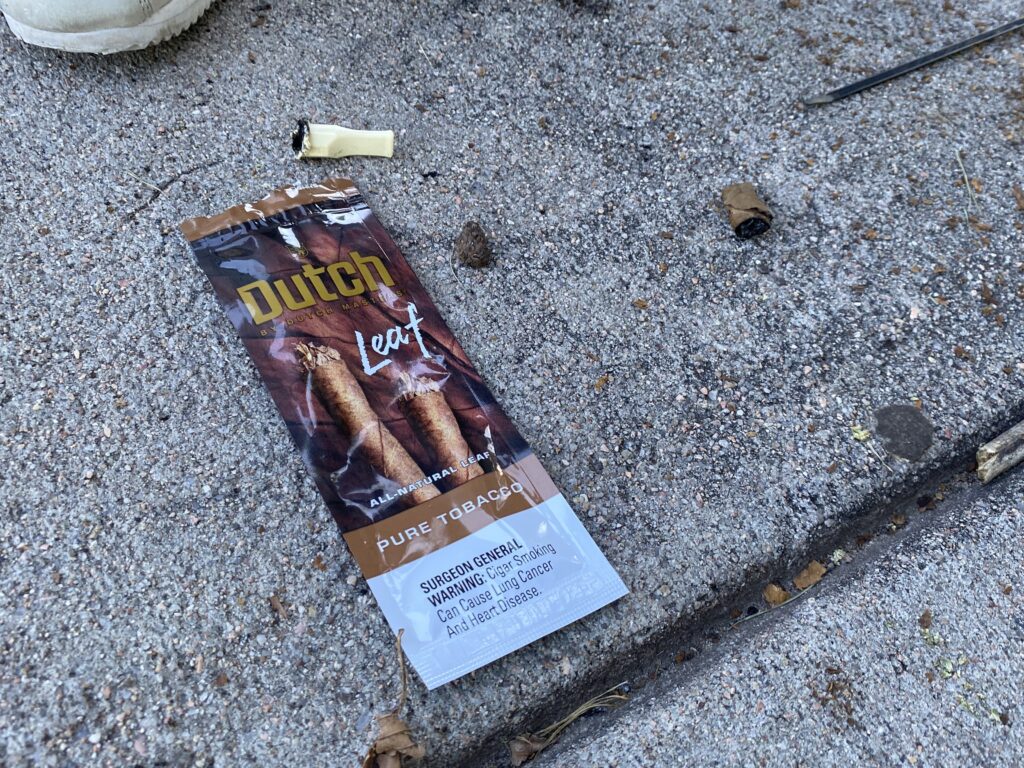
“The collective licensing, policing, regulatory, and enforcement work from local, state, and federal government officials as well as law enforcement agencies,” contradicts that figure, according to Joe Miklosi, a lobbyist for the vaping industry group Rocky Mountain Smoke Free Alliance, and former Democratic state representative.
He called it “unscientific and reliable,” and said it doesn’t align with data from the state's Department of Revenue and law enforcement agencies, which also conduct compliance checks.
Many teens get tobacco and vaping products from “parents and guardians who do not abide by the law,” Miklosi said. “Another major source of youth vaping access stems from online purchases and older friends.”
The city also said the 70 percent figure is likely too high.
“Based on our estimates from our youth operative program, we believe this number is significantly less,” said Ryann Money, public information officer for Denver’s Department of Public Health & Environment.
According to the 2021 National Youth Tobacco Survey, about 22 percent of youth e-cigarette users report obtaining e-cigarettes from a vape shop or tobacco shop in the past month. About 18 percent report getting them from a gas station or convenience store. Nearly 23 percent of students said they bought them from another person, a friend, a family member, or someone else. (About half did not purchase the products they used in the past 30 days.)
The city tracks retail sales through its tobacco enforcement division
As part of that effort, it hires youth investigators who, as part of the city’s compliance efforts, try to buy tobacco or vape products. They report what they find to the city, which fines violators.
“So I think it varies on location and just kind of when we're there,” said Adrianne, a metro Denver high schooler who worked in tobacco enforcement. We’re just using her first name to protect her identity.
She said teens looking to buy often know which stores will sell.
“Usually they know a spot and that's where everyone starts to go to, especially closer to schools or popular hangout places,” explained Adrianne.
Her experience confirms what the city says their numbers show and the statewide survey supports, that the products can be easy to get via retailers.
“Sometimes they're very good about it and sometimes they're obviously very not.”
CPR News tagged along on a city tobacco compliance visit to Headquarters Vape and Smoke on Denver’s Capitol Hill.
Owner Joe Dvorzsak said he doesn’t want to risk serving a minor and checks IDs meticulously.
“I know there are shops that aren’t as on top of it as us but when we see something like that, we don't serve that person, just out of the possibility of it getting into a minor's hands,” he said.
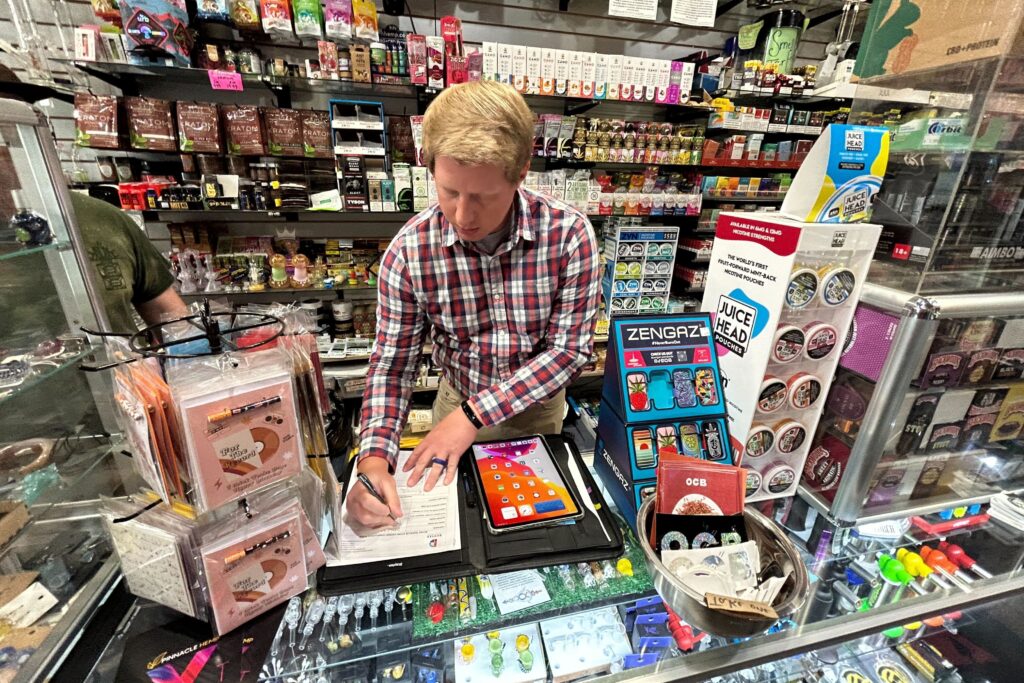
One challenge he said is what are called social sales, in which a minor will ask or pay an adult to buy for them.
“Usually ends up being someone who needs money,” Dvorzsak said. “These kids go, ‘I'll give you 20 bucks to get me something.’ And we don’t want to facilitate that transaction.”
Multiple violations by retailers can lead to the city issuing a $5,000 fine and potentially a retailer losing its tobacco license.
Brenden Gentry, the tobacco program supervisor, said some businesses have appealed their fines, noting some have said they make a majority of their money selling tobacco products.
“A few of these have said that ‘If I stop selling tobacco, my store is basically going to be closed down,’” he said. “It is a slew of people that violate whether it's small mom and pop shops, franchisee stores, big box stores, whatever it may be.”
There is a geographical element to where a lot of products get sold
Gentry noted that a lot of tobacco retailers are located in and around Denver’s communities of color. The city created a map of where these tobacco retailers are.
On the map above, you can really see they’re concentrated in and around those neighborhoods north of Interstate 70 and west of Interstate 25 — what’s called the inverted L in Denver.
CPR spoke to a doctor at Denver Health about what impact that has.
Outside the building where she works on the hospital's main campus, Dr. Ro Pereira describes disparities in the city as following what’s been called the inverted L, a shape that shows stark physical and socioeconomic barriers in the city across a variety of issues, including income, education, environmental and health measures.
“One neighborhood can be next to the other, and the disparities are huge,” said Pereira, the director of Denver Health’s Office of Health Equity and the Chief of Endocrinology.
She said a lot contributes to that: historic redlining, discrimination, and a denial of services in areas deemed a poor financial risk. And she said they’ve been targeted by tobacco industry ads and billboards.
That’s had an impact on neighborhoods already facing other serious health issues.
“Diabetes, obesity, hypertension, cardiovascular disease, cancer,” said Pereira. “And the disparities mostly affect our minority populations, so our black African American communities and our Latino Hispanic communities.”
Black, Latino, and multi-racial Denverites for example have much higher smoking rates than other groups.
Twenty-one percent of Black Denverites, 14 percent of Hispanic Denverites and almost 16 percent of multi-racial Denverites currently smoke cigarettes, according to Colorado Behavioral Risk Factor Surveillance System data from 2020 and 2022 combined. Those figures exceed those for the city as a whole (12 percent), and the city’s white (9.5 percent) and Asian (8 percent) populations.
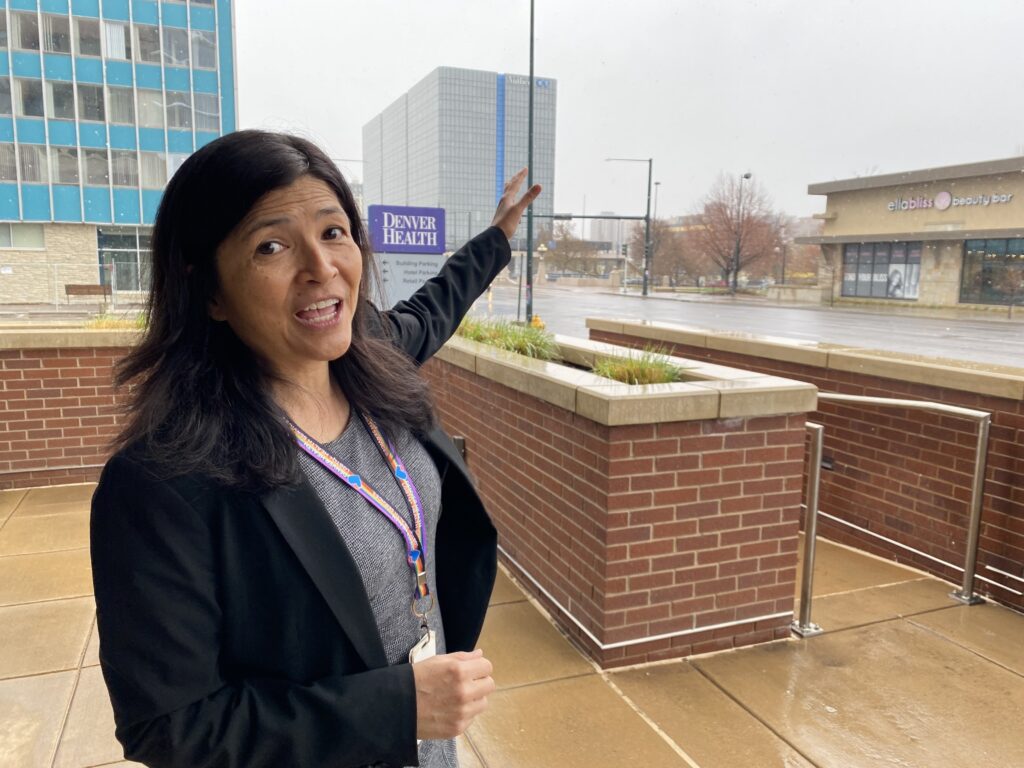
A representative for Colorado convenience stores and gas stations said those businesses are located in places where they can provide services, like fuel and convenient products, near to where a lot of people live.
“Our members like fuel stations next to interchanges on interstates and state highways because that’s where cars are,” said Grier Bailey, the executive director of the Colorado Wyoming Petroleum Marketers Association.
The disparities, regarding both tobacco and health in general, are one reason Velasco-Hernandez, who is a Latina, worries about a proliferation of tobacco advertising and retailers around her school and her neighborhood.
She said she worries about the long-term impact, especially after her uncle, who smoked and vaped heavily, died of cancer in his mid-40s. It's something she connects with that decades-long habit.
“He didn't really want to quit, so it ended up killing him,” said Velasco-Hernandez. "It’s definitely a big issue, it’s seen everywhere. Sadly here, it's been normalized. Normalized a lot for us."
Still retailers and companies that sell the products say they are obligated to ID people buying tobacco and vapes
CPR sent emails to groups representing a broad swath of retailers that sell tobacco and vaping products, including convenience stores, vape shops, pharmacy and grocery chains and tobacco and vape companies.
Some did not respond to email requests for comment before publication.
The tobacco giant Altria said it has created an incentive program for retailers to implement “a technological solution that prompts an electronic scan of a consumer’s government-issued identification to purchase any tobacco product,” in an email from a spokesperson.
It said nearly 200,000 stores nationally or more than 90 percent supported by its distribution arm are contractually obligated to have signage posted as part of the companies' retail trade programs.
The spokesperson notes it’s a founding sponsor of the We Card organization, which provides retailer training and resources to help prevent underage access. He said We Card has trained hundreds of thousands of retail employees and distributed millions of education and training materials.
R.J. Reynolds Tobacco Company said it also backs programs to train retailers and their employees how to comply with government policies, including the requirement to strictly enforce age restrictions. The company’s contracts include penalties for retailers found to have sold tobacco products to minors, which range from suspension to termination.
“At Reynolds, we remain committed to preventing youth access to tobacco products and we responsibly market the products in our portfolio. We do not want our products in the hands of youth. Period,” said the spokesperson via email.
CVS Pharmacy said it does not sell any tobacco products or vaping materials.
“We quit tobacco sales in 2014,” said Amy Thibault, Lead Director of CVS Pharmacy External Communications.
The vape industry’s Miklosi advocates restricting access and reducing the number of stores allowed to sell flavored vaping products to reduce youth vaping percentages even further.
“Treat the 200 Colorado vape shops like the 572 Colorado marijuana shops,” he said. “Three thousand convenience stores and truck stops in Colorado are too many retail establishments to regulate in order to effectively reduce youth vaping."
- We’re publishing a series about tobacco in Colorado. Here’s why
- How the tobacco industry made it cool to smoke in Colorado’s communities of color
- For those who have fought big tobacco, lobbyist’s presence on Denver Health board is ‘a contradiction’
- In Pueblo, where 60% of high school students report vaping, efforts to curb youth tobacco use are getting creative
- The unlikely affiliation between universal pre-K and nicotine taxes is a story of politics and tobacco money









